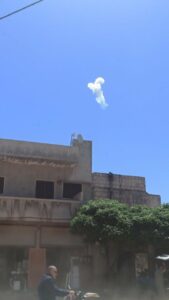On May 7, warplanes of the Russian Aerospace Forces (VKS) carried out a series of mock airstrikes over Greater Idlib in northwestern Syria as a warning to militants occupying the region.
The warplanes dropped flash bombs over Idlib city center as well as over the town of Binnish in the eastern Idlib countryside and the towns of Ma’arrat Misrin and al-Bara in the southern countryside of the governorate.
The FOTAB 100-80 flash bomb, which is designed to produce an instant intense bright flash, are usually used in such mock airstrikes. The bomb has a burning time of 2.2 to 3.5 minutes and a light intensity of 22,000 to 700,000 candlepower.
- Click to see full-size image. Via Twitter.
- Click to see full-size image. Via Twitter.
The Russian warning was likely a response to an attack on May 6, which saw militants of the Turkish-backed National Front for Liberation targeting a battle tank of the Syrian Arab Army near the town of Hantoteen in the southern Idlib countryside with an anti-tank guided missile.
The attack was a blatant violation of the ceasefire in Greater Idlib, which was brokered by Russia and Turkey more than two years ago.
Late on April 22, VKS warplanes carried out a series of mock airstrikes over Greater Idlib. The next day, a wave of airstrikes targeted militants’ positions in the region.
The situation in Greater Idlib, which is under the de-facto rule of al-Qaeda-affiliated Hay’at Tahrir al-Sham, remains unstable. Turkish forces in the region have been doing nothing to implement the ceasefire. Despite this, a military confrontation remains unlikely to happen any time soon.









Mock airstrikes ? Flash bombs ? Is Russia serious ?
No, Russia is a regional joke that empowers evil like Turds and Zionists, who kill Russians as well as their allies, whom are no more important to Russia than their enemies, ehem “partners” lol
Russia “warns” lol – Pussy Putin won’t dare strike the Turks who killed SAA men but warns their militants after they break Russian “success” story ceasefire lol
Many syrians killed turks,whats your point gimp? Russia gave one final warning,stiff sht!
Wouldn’t a flash-bomb attack make more sense in the evening or right after morning prayers?
The video appears to show midday; sure, more people would be out and about but the video capture wouldn’t be as impressive.